Posts tagged WebOS

Palm Pre Plus Sold Out on Verizon and AT&T’s websites
Aug 16th
 We don’t want to get our hopes too high with this one, but it’s certainly worth noting that the Palm Pre Plus is currently sold out on both AT&T’s and Verizon’s websites. While we absolutely want this to be an indicator that new webOS-toting hardware is ready to roll in for these two carriers, we can’t leave out the possibility that both carriers happened to run out of stock at the same time. Plus, while the phone may be sold out online, as far as we know stores are still selling Pres as usual. For now feel free to speculate, but for me, until Sprint follows suit with the older original Palm Pre I’m not convinced.
We don’t want to get our hopes too high with this one, but it’s certainly worth noting that the Palm Pre Plus is currently sold out on both AT&T’s and Verizon’s websites. While we absolutely want this to be an indicator that new webOS-toting hardware is ready to roll in for these two carriers, we can’t leave out the possibility that both carriers happened to run out of stock at the same time. Plus, while the phone may be sold out online, as far as we know stores are still selling Pres as usual. For now feel free to speculate, but for me, until Sprint follows suit with the older original Palm Pre I’m not convinced.
[Via PreCentral.net]

WebOS 2.0 slinking around in the wild?
Aug 12th
At least one sighting of yet-to-be-announced WebOS 2.0 has emerged inside the usage statistics for a WebOS Foursquare app, according to its developer.
When rummaging through the stats to discover the penetration rate of 1.4.5, he came upon one entry of 2.0, codenamed Roadrunner, though any other information is scarce at the moment. It may very well be an emulator, or someone hacking the system (though unlikely), but it could, as a best-case-scenario, be some Palm employee testing out the new OS on brand new hardware. With unicorns.
HP has claimed, since buying the company earlier this year, that development on the OS will not stop, and they will continue to honour their hardware and software roadmaps.
If you can recall, the Palm Pre and WebOS were announced together at CES in 2009. One and a half years later, that hardware and software are looking aged indeed.
Let’s hope this Roadrunner actually materializes, and doesn’t fade into smoke like the cartoon of the same name…
(via IntoMobile)
Palm Eliminates App Submission Fees, Refunds Current Developers
Jun 30th
![]() While Palm may not be the most prominent smartphone manufacturer in the market today, they sure do know how to give off a good impression. In addition to Palm’s ongoing app sale, the company now has completely done away with the $50 app submission fee for the App Catalog. Not only that, Palm is also refunding current developers their previous submission fees, telling developers to expect a credit to their PayPal account for the amount in the near future.
While Palm may not be the most prominent smartphone manufacturer in the market today, they sure do know how to give off a good impression. In addition to Palm’s ongoing app sale, the company now has completely done away with the $50 app submission fee for the App Catalog. Not only that, Palm is also refunding current developers their previous submission fees, telling developers to expect a credit to their PayPal account for the amount in the near future.
With the removal of the $50 fee it stands to question whether this will open the door to potential developers that had previously been on the fence, or if it will instead open the floodgates for low-quality applications to enter the App Catalog. I have a feeling that a measly $50 fee wasn’t holding any serious developers back from submitting their applications, but I could be wrong. Only time will tell, but personally, I fear for the future of the webOS App Catalog and the ability for quality developers to stand out among the potential saturation in the store.
Feel free to check out Palm’s Developer Blog for the full entry here.
Adobe Announces Release of Flash 10.1 for Mobile
Jun 22nd
![]() Today Adobe announced the release of Flash for any Android smartphone running FroYo, also known as Android 2.2. For now this only applies to Nexus One users and those who have flashed a custom 2.2 ROM to their Android phone. Other Android will users will have to wait patiently for their 2.2 update before they can get in on the Flash-filled fun. Don’t feel left out though if you’re not an Android user, because Adobe had plenty to say in regards to our other favorite smartphone platforms (sans iOS of course):
Today Adobe announced the release of Flash for any Android smartphone running FroYo, also known as Android 2.2. For now this only applies to Nexus One users and those who have flashed a custom 2.2 ROM to their Android phone. Other Android will users will have to wait patiently for their 2.2 update before they can get in on the Flash-filled fun. Don’t feel left out though if you’re not an Android user, because Adobe had plenty to say in regards to our other favorite smartphone platforms (sans iOS of course):
Flash Player 10.1 was also released to mobile platform partners to be supported on devices based on Android, BlackBerry, webOS, future versions of Windows® Phone, LiMo, MeeGo and Symbian OS, and is expected to be made available via over-the-air downloads and to be pre-installed on smart phones, tablets and other devices in the coming months.
They use the typical “in the coming months” phrase which could mean by the end of the year based on the slow rollout thus far. Still, it’s good to know that Adobe has done their part and that it’s up to manufacturers to make the implementation happen. Adobe also promises great performance along with accelerometer support. While that all sounds very nice, we’ll believe it when we see it.
Join us after the break for the full press release.
[Via Adobe]
SAN JOSE, Calif., — June 22, 2024 —Adobe Systems Incorporated (Nasdaq:ADBE) today announced the release of Adobe® Flash® Player 10.1 to mobile platform partners. Redesigned from the ground up with new performance and mobile specific features, Flash Player 10.1 is the first release that brings the full Web across desktops and devices. Mobile users will now be able to experience millions of sites with rich applications and content inside the browser including games, animations, rich Internet applications (RIAs), data presentations and visualizations, ecommerce, music, video, audio and more.
Already one of the top free apps on Android™ Market today, Flash Player 10.1 will be available as a final production release for smart phones and tablets once users are able to upgrade to Android 2.2 “Froyo.” Devices supporting “Froyo” and Flash Player 10.1 are expected to include the Dell Streak, Google Nexus One, HTC Evo, HTC Desire, HTC Incredible, DROID by Motorola, Motorola Milestone, Samsung Galaxy S and others. Flash Player 10.1 was also released to mobile platform partners to be supported on devices based on Android, BlackBerry, webOS, future versions of Windows® Phone, LiMo, MeeGo and Symbian OS, and is expected to be made available via over-the-air downloads and to be pre-installed on smart phones, tablets and other devices in the coming months.
“We are thrilled that more than three million Flash designers and developers are now able to unleash their creativity on the world of smart phones, tablets, netbooks, televisions and other consumer electronics,” said David Wadhwani, general manager and vice president, Platform Business at Adobe. “The combined power of the leading rich media technology platform with millions of passionate creatives is sure to impact the world in ways we haven’t even imagined yet.”
Broad Partner Support
Device and technology partners including ARM, Brightcove, Dell, Google, HTC, Intel, Microsoft, Motorola, NVIDIA, Qualcomm, RIM, Samsung, Texas Instruments and others announced more specifics around their support for Flash Player 10.1 today.
Content publishers including AgencyNet, AKQA, Armor Games, Blitz, CNET.com, HBO, JustinTV, Kongregate, Mochi Media, Msnbc Digital Network, Turner, Nickelodeon, Odopod, Photobucket, RAIN, Roundarch, Sony Pictures, South Park Studios, USA Network, Viacom, Warner Brothers and many others have also started to optimize Flash content to deliver the best possible experience within the context of smaller screens, which includes larger buttons for interactions, layout adjustments for mobile screens and more.
For details visit www.adobe.com/go/flashquote_sheet_101 or m.flash.com, Adobe’s showcase site for optimized Flash content. For more information on how to optimize Flash content for mobile, visit www.adobe.com/go/fpmobile.
New High Performance Features
Completely redesigned and optimized for mobile, Flash Player 10.1 delivers new interaction methods with support for mobile-specific input models. Support for accelerometer allows users to view Flash content in landscape and portrait mode. With Smart Zooming, users can scale content to full screen mode delivering immersive application-like experiences from a Web page. Performance optimization work with virtually all major mobile silicon and platform vendors makes efficient use of CPU and battery performance.
The new Smart Rendering feature ensures that Flash content is running only when it becomes visible on the screen, further reducing CPU and battery consumption. With Sleep Mode, Flash Player automatically slows down when the device transitions into screen saver mode. Advanced Out-of-Memory Management allows the player to effectively handle non-optimized content that consumes excessive resources, while automatic memory reduction decreases content usage of RAM by up to 50 percent. Flash Player pauses automatically when events occur such as incoming phone calls or switching from the browser to other device functions. Once users switch back to the browser, Flash Player resumes where it paused.
Industry Analyst Feedback
“Although it is labeled a dot release, Flash Player 10.1 is a significant update that includes a number of new performance and mobile specific features,” said Al Hilwa, program director of the Application Development Program at IDC. “This allows consumers to see a much bigger part of the Web and allows developers to bring their Flash Platform skills to a much bigger swath of devices.”
“For the past few weeks I have had the opportunity to test an Android Froyo device loaded with a beta of Flash Player 10.1,” said Ben Bajarin, principal analyst at Creative Strategies. “The overall experience and performance of Flash has been impressive. Mobile users now have access to full Web pages with rich Flash content on millions of sites. With the new mobile specific features, developers also have an important opportunity to help shape the way Web content, games, touch capabilities and more are presented across platforms and devices as Froyo and other platforms deliver full Flash support.”
Additional Resources
To watch demo videos of Flash Player 10.1 running across devices, including smart phones and tablets, visit www.adobe.com/devnet/devices/demos.
Availability
Flash Player 10.1 is expected to be available as a final production release for devices once users are able to upgrade to Android 2.2 “Froyo.” Once upgraded, smart phones, tablets and other devices can be updated with Flash Player 10.1 over-the-air via numerous ways including content triggered downloads, system software updates and on-device app catalogs such as Android Market, Adobe Labs and other venues. The upgrade mechanism will vary by device and device manufacturer. The desktop version of Flash Player 10.1 for Windows, Mac OS and Linux is available on http://get.adobe.com/flashplayer today.

HP Partners with Vidyo, webOS Video Conferencing to Come?
Jun 16th
 With HP’s upcoming acquisition of Palm, the company has been making a few interesting partnerships including its most recent, that with the video conferencing company Vidyo. Now before we start going bonkers thinking about the possible implementations in Palm’s webOS, realize that HP has announced that the first signs of the partnership will show up on its TouchSmart PC. That said, they didn’t leave us completely hanging to guess whether it will find its way onto mobile devices. Darren Podrabsky from HP dropped a little wisdom on the subject of video conferencing on mobile:
With HP’s upcoming acquisition of Palm, the company has been making a few interesting partnerships including its most recent, that with the video conferencing company Vidyo. Now before we start going bonkers thinking about the possible implementations in Palm’s webOS, realize that HP has announced that the first signs of the partnership will show up on its TouchSmart PC. That said, they didn’t leave us completely hanging to guess whether it will find its way onto mobile devices. Darren Podrabsky from HP dropped a little wisdom on the subject of video conferencing on mobile:
No official statements from me, but this is a software-based technology. We’ve talked about the desktop. Think mobile. Think about your phone. HP just acquired Palm. Think about how many legs something like this has. Feel free to speculate.
Lucky for Darren we love to speculate, and to add to the speculation I’d like to highlight the fact that Vidyo has a SDK to bring it’s services to Android, Moblin, and MeeGo, devices so it can be too far of a reach to extend similar functionality to the webOS. Let’s hear it! Who’s ready to do some video chatting on their phone? You know, that or your printer.

The webOS and a Little Thing Called Overclocking
Jun 10th
If you recall last week’s article you will remember how much patching can change the experience of the webOS, and how it can address core issues with the operating system. This time I’m going to detail the process of CPU scaling in an attempt to fix two of Palm’s devices’ largest problems: speed and battery life.
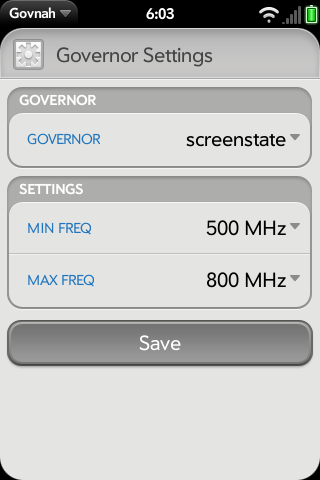
Unfortunately CPU scaling only works on the Pre and Pre Plus with no love for the Pixi underparts, which desperately could use the speed boost. Once you have installed PreWare on your Pre, getting overclocking ready to go is very easy. It requires just two homebrew applications which can be found in PreWare. The first is under the “kernel” section and is called UberKernel. UberKernel is a replacement for the webOS stock kernel and allows greater control of the CPU. After installing UberKernel, you will need an application to actually control that kernel.
The application Govnah will allow you to do just that, while also monitoring your device’s temperature as overclocking can potentially get your phone all hot and bothered. Govnah has a lot of different settings and options but I’m going to focus on just one particular mode-the screenstate mode. When the user selects the screenstate option they essentially choose to base the CPU’s clock speed on the whether the screen is on or off. This setting makes a lot of sense because it allows users to overclock the CPU and improve performance when the phone is actually being used, (when the screen is on) and underclock the CPU to slow battery consumption when the phone is idle (when the screen is off).
The Palm Pre features Texus Instrument’s OMAP3430 processor which is clocked at 600 MHz by default. With UberKernel and Govnah you can overclock that processor to 800MHz and underclock it to as little as 125MHz, however it can apparently cause some instability if the CPU is clocked that low, so 500MHz is recommended as a minimun clock speed. There are of course other speeds available including 720MHz, 600MHz, 550MHz, and 250MHz so you can pick whatever speed you fancy.
If you do decide to go ahead with the CPU scaling process you can expect some really nice performance boosts with your phone’s CPU set at 800MHz without too significant of a hit on battery, or you can choose some more conservative clock speeds to stretch battery life. However, there are some limitations to the UberKernel as pointed out by the folks at webOS internals.
The Uber Kernel will not help you attract the opposite sex. It may in fact hinder you.
- You: Hey there, can I buy you a drink?
- Him/Her: Your pants are really hot.
- You: Why thank you. I like members of the opposite sex looking at my pants.
- Him/Her: No, seriously, I think they just caught on fire.
- You: NOOOOOO!!!! Screw you UBERRRKERNELLL!!!
All kidding aside, overclocking could theoretically cause your phone to get pretty toasty though there have been very few reports of people damaging their hardware this way, nevertheless keep an eye on the temperature reading. Now you’re on your own with this one and you will basically be voiding your warranty if you go for it, but it is easy to uninstall both the UberKernel and Govnah if you feel the need to bail.
Check out the PreCentral Forums thread for more information here.
The webOS and the Argument for Patching
Jun 2nd
It seems a consensus among the blogosphere that the webOS is one of the most fluid and user-friendly mobile operating systems on the market today. That said, while it may be fun and innovative with its card-switching and intuitive multitasking, there are also a lot of serious issues surrounding the core webOS experience. Luckily for Pre and Pixi users there is much more to be had than the out-of-box experience you get with the webOS by way of homebrew development.
Homebrew is fairly similar to jailbreaking an iPhone in that users are able to install custom applications outside of the device’s built-in application store. What is different is that while Apple clearly disapproves of jailbreaking on their devices, Palm has allowed and even encouraged homebrewers. Homebrew on the webOS doesn’t bog the system down where I find that jailbreaking on the iPhone tends to make things a little wonky and, with older generation hardware, often renders devices almost unusable.
While homebrew includes full-on applications it also encompasses things called patches, which essentially change individual characteristics of the webOS. For example a popular patch is to include the battery percent icon in the top bar on the screen, while another is to redo the launcher with more icons and more pages of applications. While these may seem like minute tweaks in the operating system, the usage of many different patches can really alter the look and feel of a device. Many users have anywhere from five to 30 or 40 patches installed on their devices enabling many options that aren’t built into the stock experience.
The actual process of getting homebrew on your phone may seem a little daunting at first, but I assure you it’s extremely simple. I’m not going to go into detail about the steps of getting things going here, but PreCentral has an excellent walkthrough on how to get started. Once you have followed the steps you will have an app on your phone called PreWare. PreWare is a lot like Cydia on a jailbroken iPhone in that you can download all of your patches and homebrew applications from there while still keeping the official App Catalog for everything else. Within PreWare it’s fairly easy to navigate through full applications, patches, kernels, linux applications, etc. Most of the patch titles are self-explanatory so just pick the one’s that sound good and start installing.
This week I’ve taken the chance to steal my girlfriend’s Palm Pre Plus and see what the buzz is about homebrew and more specifically, patching. With just a little work I managed to make her Pre more elegant and more useable and I barely scratched the surface of what the homebrew community has accomplished. Off the top of my head some of the patches I installed are: 4×4 icons in the launcher, glass effect, battery as percentage, slide to end call, haptic feedback on dialer, iPhone spoof agent (websites identify the Pre as an iPhone for better browsing), Verizon aGPS fix, and turn on GPS only when using Google Maps. While I plan to do some more patching, the next step is going to be CPU scaling and trying some methods to improve battery life.
If you are a webOS user out there and haven’t checked out homebrew at all, I’m telling you, go get your hands dirty and unlock the potential of your device. If your Pre or Pixi is starting to feel a little dated and boring, this is a really fun way to make it feel new again. The best thing is that most homebrew stuff is safe and won’t void your warranty and worst-case scenario you will have to wipe your device and start over but you should have most of the important stuff backed up on your Palm Profile anyway, so rest easy.

webOS Heading to HP Tablet PC’s and Printers?
May 19th
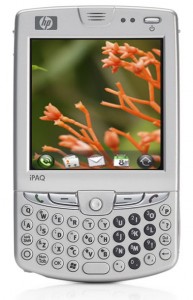
The dust has settled from the HP buyout of Palm, and Palm enthusiasts have been patiently awaiting word on what will happen to their beloved webOS. There was some Twitter chat about possibility of HP using the beleaguered OS on their aging iPaq devices, which to me would be quite interesting to use.
Today, Mark Hurd, CEO of HP released the following statement:
“in order to enhance our intellectual property…in the connected-mobility space. We expect to leverage WebOS into a variety of form factors, including slates and Web-connected printers,”
“With a whole series of Web-connected printers, as they connect to the Web, they need an OS,” he added
HP plans to invest “heavily” into webOS, and focus not only on mobile phones, but also on up-and-coming tablet PCs and printers. To date, the only other operating system showing the potential expansion outside the mobile realm is Android, which itself is growing faster than any other mobile platform. webOS, in my opinion, is an acquired taste for those who aren’t too concerned about apps (though that may change), but more in need of a fast, reliable alternative to iPhone or Android. webOS never gained the mainstream popularity that Palm had hoped for, which in turn, led to their eventual demise and buyout.
But as of late, with HP pushing online connecting printers that have their own apps available for download, could its expansion into peripherals be what webOS needs to really gain momentum? Could it be more popular running on a microwave than the cell phone that it was developed for?
Only time will tell, but kudos to HP for trying to innovate instead of duplicate.
[Via CNET]
Follow me on twitterwebOS 1.4.1.1 Hitting Verizon Today?
Apr 28th
Verizon has posted on their Pre Plus support site that webOS 1.4.1.1 will be dropping “soon.” PreCentral has received an anonymous tip that claims the update may be dropping April 28th, which just so happens to be today! This is good news for Verizon Pre Plus and Pixi Plus users as they have been left out of the 1.4.1 party so far. We know that Sprint and International carriers received the update at the end of March, bringing bug fixes and access to the App Catalog for International users. Verizon users will be seeing the full 1.4.1.1 update as opposed to just the 1.4.1 update (confusing right?). The main optimization in 1.4.1.1 is that it handles background processes better by terminating them in a larger timeframe than that in 1.4.1. Just trust us, it’s a good thing. The update should also bring relief to Verizon Pre Plus users who have been suffering from keyboard issues that cause frequent double letters or failure to register key presses at all. Hit the break for the full changelog, and keep your finger on the update button. Be sure to let us know in the comments if it drops for you.
(Via PreCentral)

Is Palm up for Sale?
Apr 12th

I can’t really say this is the biggest surprise to start the week. With less than stellar sales of their webOS Palm Pre/Pixi (and Plus models respectively). Word on the street is that the troubled phone maker is working with Goldman Sachs and Qatalyst Partners to find a potential suitor to buy them out, with HTC and Lenovo supposedly in the running to do so.
Nothing in terms of sale price has been mentioned yet, but with the company having lost much of its valuation in the last two weeks, since their terrible quarterly results (their shares currently sitting at $5.86/share) this could be Palm’s best exit strategy. Palm CEO Jon Rubenstein recently claimed that the company was definitely not for sale, but in these harsh economic conditions, the best offer is one that lets the underdog rest easy. Palm, if they shack up with HTC or Lenovo, could have the financial backing to improve WebOS significantly, and build the hardware that the Pre promised (and largely failed) to be.
We will be going over the main advantages WebOS has over Android and vice versa in the coming days, and will update on the latest on Palm’s acquisition. Or lack thereof.
Damn, rumours.
(via Engadget, via Bloomberg)

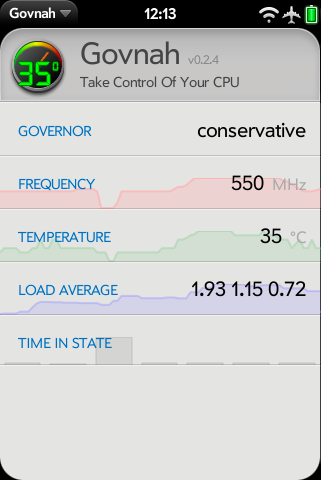
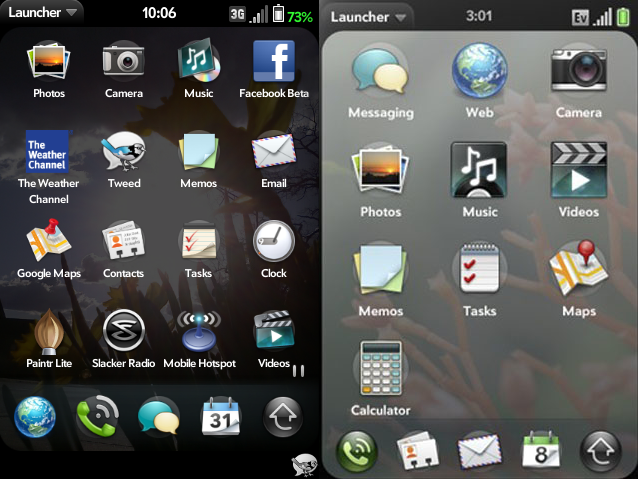
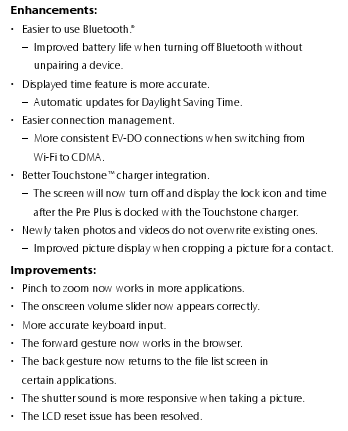





Interact With Us